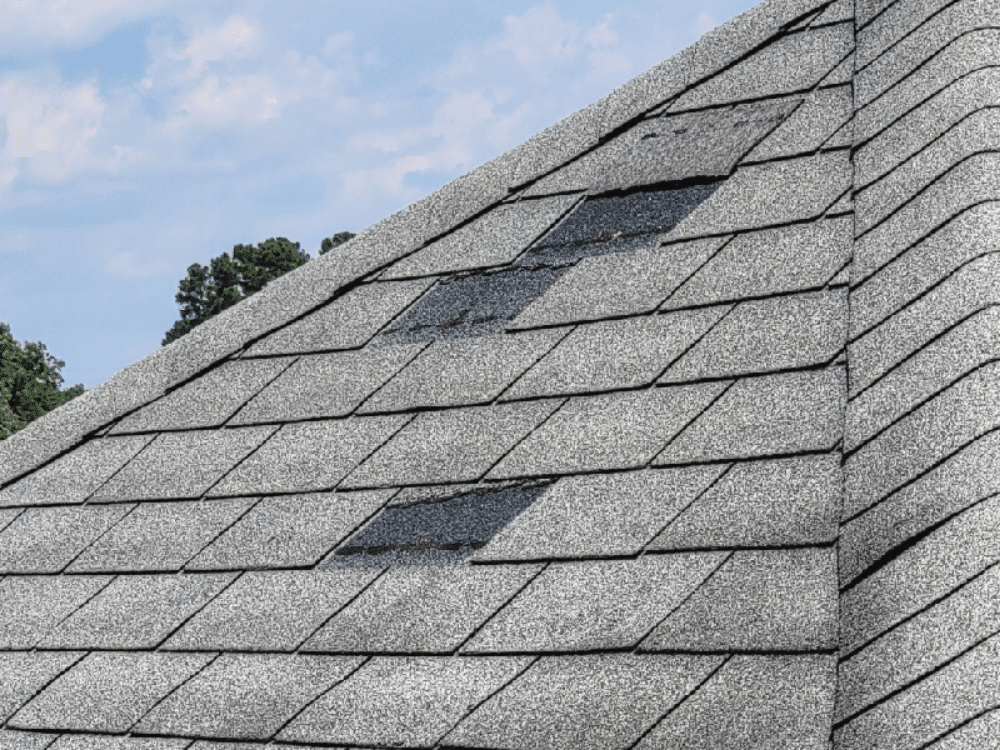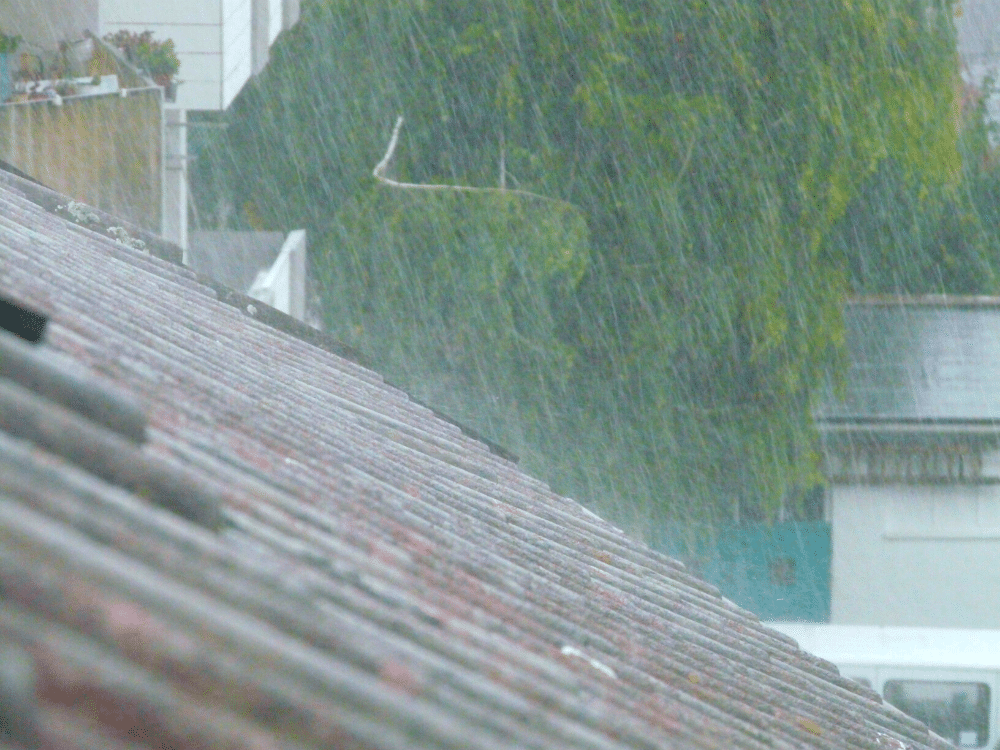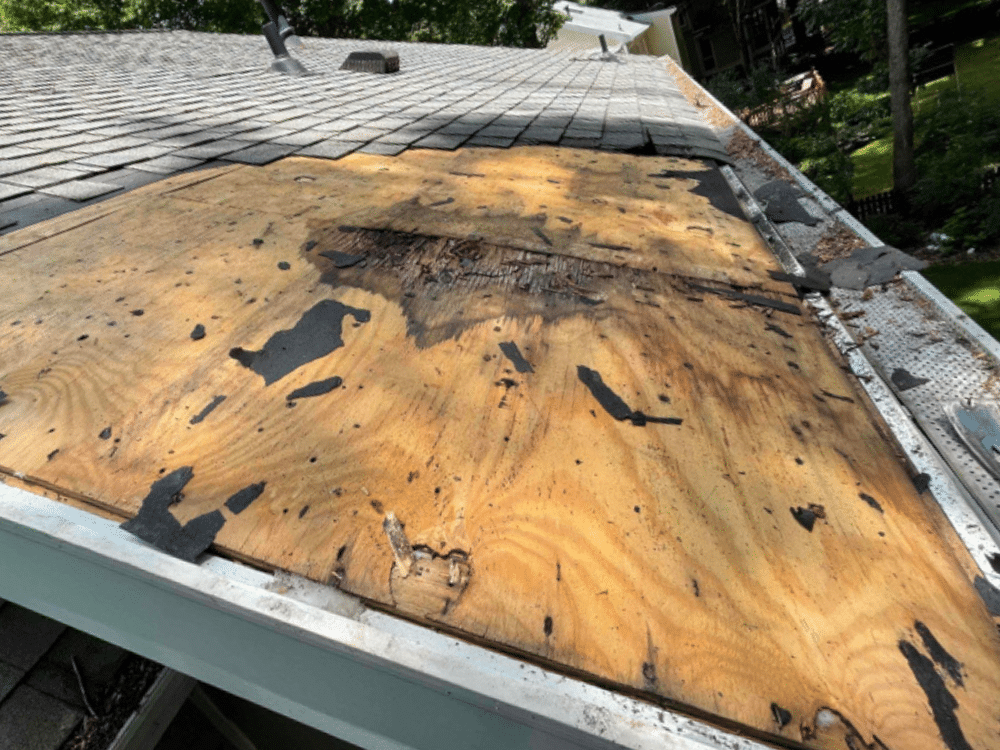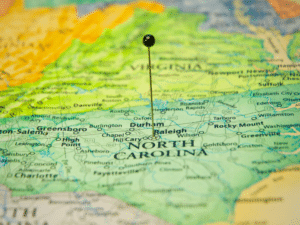
Ana, Bill, Claudette, Danny, Elsa, Fred, Grace, Henri, Ida,..what letter of the alphabet are we on now? Every day the news announces a new hurricane. Okay, we are exaggerating, but there have been a lot of storms. With peak hurricane season here and roofers already knocking on your door, you’re probably wondering, “How does hurricane damage affect my roof? What does storm damage look like?”
Without a doubt, North Carolina is a hurricane-prone area with strong winds and wind-driven rain. While hurricane weather is milder in Raleigh-Durham than on the coasts, they can still cause damage.
Overall, there are five properties of storms that can affect your roof:
We’ll describe each weather condition below and how they could damage your roof.
As a side note: we will be discussing these weather conditions as they affect roofs in the Raleigh Triangle Area of North Carolina. Roof damage can vary both by region and severity of the storm.
Hurricanes Weather and Roof Damage
1. Wind

Wind speed is the #1 factor that determines the severity of a hurricane.
Not only does the wind itself damage your roof, but it also creates wind-driven rain. We’ll discuss the effects of rain soon.
For now, let’s talk about the effects of wind on its own.
We checked in with our roofing experts to discover the most common types of wind damage in the Raleigh area. With over twenty years of experience in the construction and roofing industry.
He finds that wind most commonly leads to creased, broken, loose, or missing shingles. Heavy winds makes older shingles to lift up and form creases.
These aren’t always noticeable after the storm because the shingles flip back down. Homeowners can go months or even years without knowing there is an issue.
Flipped over shingles will crease and eventually break and cause leaks. It’s like a piece of paper. You fold it on a crease enough times, and it will eventually break.
Abel F. – Owner
Are creased shingles that bad? Yes. Because the shingles are loose, they create an entry point for water.
Until the shingles fall off, you may not actually notice any leakage. However, water can slowly seep under the shingles and create weak points in your roof. This includes rotting sheathing boards.
Luckily, missing shingles are a quick and minor repair. However, you want to schedule the repair sooner than later.
Otherwise, the missing shingles will allow water in, leading to sheathing rot and greater repair expenses.
To recap, wind most commonly leads to missing, loose, and creased shingles. In most instances, these are a quick repair. However, if the wind damage is extensive enough, you’ll want to consider filing a claim with insurance (more on that in our next blog post!)
2. Rain

Wind-Driven Rain & Leaks
Wind-driven rains can create roof leaks where normal rains would not.
Why?
Because the wind drives the rain to hit your home at odd angles. These odd angles allow the water to hit and seep into areas that otherwise would be water-tight.
One example of this would be your roof’s ridge vent.
Most homes have a filtered vent along the peak of their roof to allow for attic ventilation. These vents are necessary.
Nonetheless, during heavy wind-driven rain, small amounts of water can seep through them into your attic space.
Luckily, hurricane rains in Raleigh shouldn’t cause too much water intrusion from this type of leak.
Bonus fact: Your windows and siding can develop leaks from wind-driven rain, too. If water is coming sideways and hitting your windows, it could enter through areas with worn sealant or rotted wood.
Rain Intensity
Aside from hitting your roof at odd angles, hurricane rain does the most damage by just being…well…heavy rain.
Hurricane rain is quick, heavy, and comes in high volumes.
As mentioned in our last post on hurricane weather in the NC Triangle, the Raleigh Triangle area receives low rainfalls during hurricanes compared to the rest of the state.
Nonetheless, the rain is still intense and can damage your roof.
Heavy rains can cause storm damage by…
a. Penetrating weak areas of your roof
If you have a section of your roof that is worn down or damaged, heavy rains can easily soak into these areas and cause leaks.
These areas include nail pops, loose shingles, missing shingles, damaged flashing, failing vents and worn boots.
To prevent this, we recommended having a roofer inspect your home every 8 years to check for any areas that might need maintenance. A roof tune-up is much cheaper than a large leak repair.
b. Weakening areas of your roof
Heavy, consistent rain on your roof will naturally wear down areas of your roof. This does not cause any immediate issues. Instead, it can take multiple storms to cause noticeable damage.
Top areas include:
- Roof edges near your gutters
- Roof valleys
- Shingles underneath downspout exits
- Chimneys
- Dormers
c. Causing wood rot & sheathing damage
Lastly, hurricanes can contribute to wood rot.
Wood rot, similar to weakening shingles, happens slowly over time.
If you have a weak area of your roof, you might not develop an obvious roof leak.
Instead, the sheathing boards under your roof might soak up water and slowly rot over time.
In some cases, this sheathing creates a leak.
In other instances, the wood rot is not discovered until a full roof replacement.
Wood rot is not 100% preventable.
Wood is not meant to last forever, and siding or wood near your gutters or roofline will naturally rot sooner than other sections of your house. Most homes need at least minimal siding and wood rot repairs once their home reaches 20 years in age.
Pro tip: make sure your roofing contractor replaces all rotted sheathing during a roof replacement.
3. Standing Water

If your roof has shingled areas with low slopes, these sections could accumulate standing water during heavy rains.
When a roof has a low slope (i.e. it is not very steep), we often recommend installing a metal or rubber roof over the area as these roofing materials allow for better drainage.
However, if this is not an option, we recommend ensuring that the roof has ice & water shield (a thick waterproof underlayment) under the shingles.
When you have standing water on your roof that is not draining, it will start to seep through any seams it can find and cause significant damage.
Gutters can also initiate standing water issues.
If your rain gutters are too small to handle heavy rainfall, the gutters could overflow.
As a result, backed up water can seep behind the gutters and under the shingles.
At Artisan, we install drip edge wherever possible along the roof edge to create an extra barrier of protection between the roof and gutters.
When your gutters are extremely clogged, debris can pile up on your roof. With heavy rains, the debris will soak up large amounts of water. Wet debris will damage and wear down your asphalt shingles.
Not only that, but the debris can decompose and break down over time, leading to algae and moss growth on your roof and further damage to your shingles.
4. Debris

With heavy winds comes flying debris.
Don’t worry, your house probably won’t swirl away and end up in Oz.
Nonetheless, with the number of trees in North Carolina, you’re bound to have some branches and leaves flying about.
Fallen tree damage claims are one of the most common roof repair claims in North Carolina.
Typically, smaller branches only damage a few shingles.
However, when a larger branch or tree hits your home, you’ll need anything from a few shingles replaced to a partial roof and gutter replacement.
In extreme circumstances, your roof may even need structural repairs.
5. Hail

Lastly, we have hail: small or large ice pellets from the sky. They can range from the size of a pebble to the size of a grapefruit.
Hail can dent and damage cars, windows, window screens, skylights, flashing, gutters, vent covers, and shingles.
Although it’s rare, a hurricane can turn into a hail storm.
On September 25th, 2020 we had an intense hail storm that sent insurance claims through the roof in Apex, Cary, and New Hill, North Carolina. One year later, we were still receiving calls requesting storm inspections from that storm.
As far as shingles go, hail can dent shingles and cause granule loss.
While this does not create any immediate issues, hail can significantly wear down your shingles and decrease their overall lifespan.
That covers it! We hope this overview of hurricane roof damage was helpful.
Need an estimate or storm inspection? Unlike many storm chasers, we will inspect your roof for storm damage and provide you with an honest assessment of our findings. No damage? We’ll let you know. Schedule a free inspection today.



